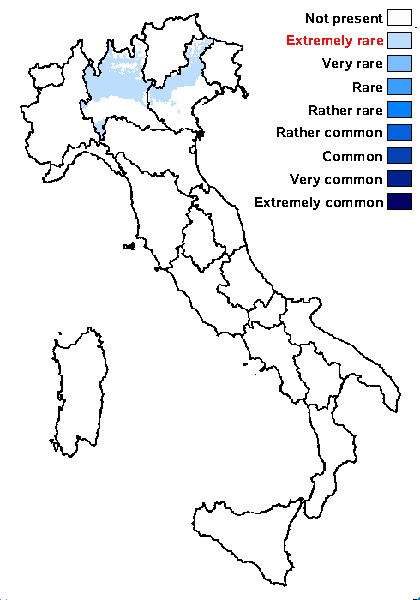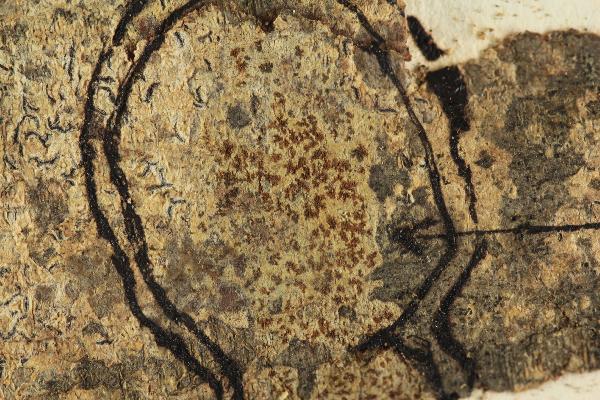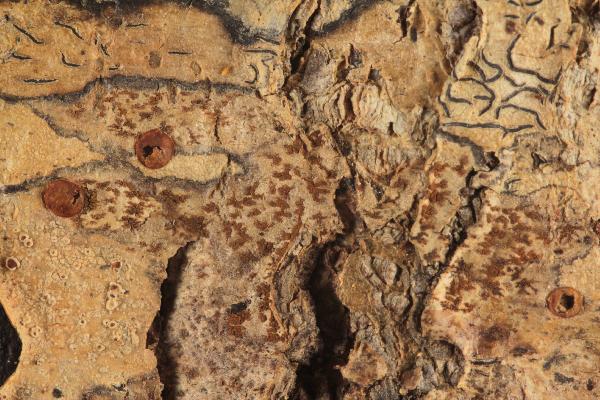Synarthonia ochracea (Dufour) Van den Broeck & Ertz
in Van den Broeck & al., Pl. Ecol. Evol., 151, 3: 343, 2018.. Basionym: Arthonia ochracea Dufour - J. Phys. Chim. Hist. nat. Arts, 87: 205, 1818.
Synonyms: Arthonia cinnabarina var. ochracea (Dufour) Nyl.; Conangium ochraceum (Dufour) Fr.; Coniocarpon ochraceum (Dufour) Fr.; Opegrapha ochracea (Dufour) Hepp
Distribution: N - Ven (Trevisan Lich. Ven. 134), Lomb (Van den Broek & al. 2018).
Description: Thallus at first inapparent and non-lichenized, developing on the thalli of Graphis scripta s.lat., later becoming lichenized and autonomous, up to 18 μm thick, whitish to pale brown, smooth to cracked, without a distinct prothallus. Apothecia lirelliform, often stellate to lobed, at first immersed, then semi-sessile, solitary (and then 0.1-0.5 x c. 0.1 mm), or in clusters of 2-4 measuring 0.6-0.8 x 0.3-0.5 mm, with a blackish, but heavily ochraceous orange (cinnamon)-pruinose, flat disc, without a distinct proper margin. Proper exciple 10-25 μm wide laterally, brownish; epithecium orange-brown, 20-25 μm high; hymenium brownish to reddish 40-60 μm high, I+ deep blue, K/I+ deep blue with purplish patches; paraphysoids 1.5-2.2 μm thick, the apical cells colourless, hardly swollen, immersed in gel; hypothecium orange-brown, c. 30 μm high. All apothecial parts (in section) more or less inspersed with clusters of granular, orange-brown crystals reacting K+ purplish to reddish. Asci 8-spored, ellipsoid to obovoid, semi-fissitunicate, with a K/I+ blue ring-structure in tholus and an ocular chamber visible in young asci. Ascospores (2-)3(-4)-septate, slightly constricted at septa and with an enlarged apical cell, hyaline but turning brown and ornamented when overmature, oblong-ovoid, 11.5-17 x 4-7.5 μm, with a c. 0.7 μm thick gelatinous perispore. Pycnidia immersed to erumpent, pale, the wall composed of brown-walled hyphae. Conidia simple, hyaline, bacilliform, 4.2-5.3 x 0.8-1.3 μm. Photobiont probably absent in young lichenicolous thalli, then trentepohlioid. Spot tests: thallus K+ yellowish, C-, KC-, PD-, UV+ pale orange; apothecia K+ purplish, UV+ dark orange. Chemistry: apothecia with crystals of anthraquinones, mainly parietin. Note: a rare, misunderstood species (often considered as a synonym of Coniocarpon elegans), which probably starts the life-cycle as a non-lichenized parasite on the thalli of Graphis scripta, later becoming autonomous. All Italian records date back to the 19th century.
Growth form: Crustose
Substrata: bark
Photobiont: Trentepohlia
Reproductive strategy: mainly sexual
paras Graphis scripta when young
Commonnes-rarity: (info)
Alpine belt: absent
Subalpine belt: absent
Oromediterranean belt: absent
Montane belt: extremely rare
Submediterranean belt: extremely rare
Padanian area: absent
Humid submediterranean belt: extremely rare
Humid mediterranean belt: absent
Dry mediterranean belt: absent

Predictive model

Source: http://dryades.units.it/lichenothecaveneta/images/species/0134_3.JPG
Trevisan, Lichenotheca Veneta 134
Growth form: Crustose
Substrata: bark
Photobiont: Trentepohlia
Reproductive strategy: mainly sexual
paras Graphis scripta when young
Commonnes-rarity: (info)
Alpine belt: absent
Subalpine belt: absent
Oromediterranean belt: absent
Montane belt: extremely rare
Submediterranean belt: extremely rare
Padanian area: absent
Humid submediterranean belt: extremely rare
Humid mediterranean belt: absent
Dry mediterranean belt: absent

Predictive model

 INDEX FUNGORUM
INDEX FUNGORUM
 GBIF
GBIF
 DOLICHENS
DOLICHENS




